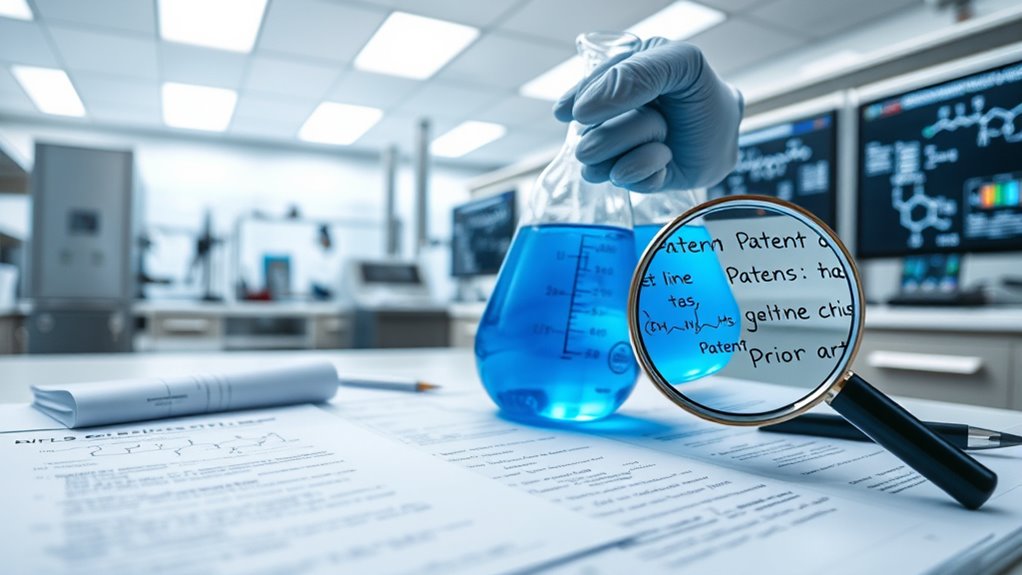As a chemist, understanding patents means knowing how claims define the scope of your invention, with broader claims offering more protection but risking validity issues. Prior art includes anything publicly available before your filing that could challenge your novelty. Developing a solid patent strategy balances broad enough claims for protection while avoiding invalidation. Focusing on these fundamentals helps safeguard your innovations effectively—if you want to explore how to craft strong claims and navigate prior art, there’s more to discover.
Key Takeaways
- Patent claims define the scope of protection and should be carefully drafted to balance breadth and defensibility.
- Conduct thorough prior art searches to ensure novelty and avoid invalidation of chemical inventions.
- Broad claims offer extensive protection but risk validity challenges; narrower claims are easier to defend.
- Regularly monitor the patent landscape to maintain validity and adapt strategy as needed.
- Collaborate with patent professionals to craft robust claims and develop effective patent strategies for chemical innovations.

Have you ever wondered how chemists protect their innovative discoveries? The key lies in understanding the fundamentals of patents, especially how the patent scope and patent validity work together to safeguard your inventions. When you file a patent application, you’re essentially defining the boundaries of your innovation through claims. These claims specify what aspects of your invention you’re seeking to protect, and they determine the patent scope. A broad claim can cover a wide range of similar inventions, giving you more control and exclusivity. However, if your claims are too broad, they might be challenged during examination or later infringement disputes, risking your patent’s validity. Conversely, narrower claims might be easier to defend but could limit your market protection. Striking the right balance is vital for effective patent strategy.
Understanding patent validity is equally important because it directly impacts whether your patent will stand up against challenges. A valid patent must meet certain criteria: it should be novel, non-obvious, and sufficiently disclosed. If any of these elements are lacking, the patent could be invalidated, rendering your efforts useless. For example, if your invention isn’t truly new because it was already disclosed in prior art, your patent application might be rejected or later invalidated. That’s why conducting thorough prior art searches before filing is essential. It helps you identify existing disclosures and craft claims that are more likely to withstand legal scrutiny. Remember, patent validity isn’t just about the initial application; it’s an ongoing consideration throughout the patent’s lifespan. Regularly monitoring the patent landscape and defending your claims when necessary can bolster your rights and maintain your competitive edge.
Additionally, understanding how prior art searches influence patent validity can significantly enhance your patent strategy. Your strategy should also include carefully drafting claims that clearly delineate your invention’s scope without overreaching. Overly broad claims risk being invalidated for encompassing prior art, while overly narrow claims might not provide enough protection. Balancing patent scope and validity ensures that your patent is both enforceable and valuable. It’s essential to work with patent professionals who understand the intricacies of patent law and can help you craft claims that are robust and defensible. By paying close attention to patent scope and maintaining a focus on patent validity, you set a strong foundation for protecting your chemical innovations. This strategic approach can prevent future legal disputes, maximize your patent rights, and ultimately help you secure the commercial advantage you deserve.
Frequently Asked Questions
How Do I Determine if My Invention Is Patentable?
To determine if your invention is patentable, start with a novelty assessment by searching existing patents and publications to verify it’s new. Then, evaluate the inventiveness criteria to confirm your idea isn’t obvious to skilled professionals in your field. If your invention shows both novelty and inventiveness, it’s likely patentable. Consulting a patent attorney can help refine your assessment and strengthen your application.
What Are the Common Pitfalls in Drafting Patent Claims?
When drafting patent claims, you often fall into pitfalls like overly broad or narrow claim scope, which can weaken your protection or invite infringement. Avoid ambiguity by clearly defining your invention’s features, and make certain your claims are precise and supported by your disclosure. Be cautious of using vague language, as it can lead to interpretation issues. Focus on careful claim drafting to maximize your patent’s enforceability and coverage.
How Can I Effectively Conduct a Patent Prior Art Search?
To effectively conduct a patent prior art search, start by searching databases like USPTO, EPO, or WIPO. Use relevant keywords that describe your invention, including synonyms and related terms. Be thorough—explore patent classifications and references cited in similar patents. You should also review scientific literature and technical journals. This all-encompassing approach helps you identify existing patents and publications, ensuring your invention is novel and non-obvious.
What Strategies Can Strengthen My Patent Application?
To strengthen your patent application, focus on demonstrating the novelty requirement and inventive step. Clearly highlight how your invention differs from prior art and emphasizes its unique features. Draft detailed claims that cover broad concepts while supporting them with specific examples. Conduct thorough research to anticipate potential objections, and consider consulting a patent attorney to refine your strategy. This approach maximizes your chances of securing robust, enforceable patent rights.
How Do Patent Laws Differ Internationally for Chemists?
You need to understand that international differences in patent laws stem from varying legal frameworks, affecting how chemists protect inventions globally. Some countries require detailed disclosures, while others have different standards for novelty or inventive step. You should research specific jurisdiction requirements, consider filing via international treaties like the Patent Cooperation Treaty (PCT), and tailor your patent strategy accordingly to make sure your chemical innovations are protected across different markets effectively.
Conclusion
Now that you understand patent claims, prior art, and strategy, you’re practically a superhero in the chemistry world! With this knowledge, you’ll wield the power to protect your inventions like a shield, outsmart competitors like a chess master, and carve your name into the patent hall of fame. Never again will your groundbreaking ideas be vulnerable—you’re now armed with the ultimate secret weapon to dominate the patent universe!









